Événement Conférence
The Environmental Agenda of International Geneva
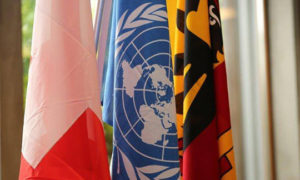
01 Sep 2020
09:00–10:20
Lieu: International Environment House II (7-9 ch. de Balexert) & Webex Event
Organisation: Geneva Environment Network
Geneva is a global hub for international environmental governance. This session, dedicated to new comers to international Geneva, provided an introduction to the key areas of environmental activities in Geneva.
About this session
Geneva is a global hub for international environmental governance where numerous intergovernmental organizations, permanent governmental missions, NGOs, platforms, academic institutions and other stakeholders contributing to the global environmental agenda are based. Geneva is, therefore, an ideal location to reinforce and develop synergies among these actors.
This session, convened by the Geneva Environment Network, introduced new stakeholders to international Geneva, its environmental community, major events and negotiations taking place in the region in the following key thematic areas: chemicals and pollution, climate, digital cooperation, eco-humanitarian, green economy, nature, human rights and environment.
Speakers
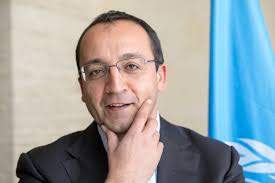
H.E. Amb. Salman BAL
Director, Centre d'Accueil de la Genève internationale (CAGI)
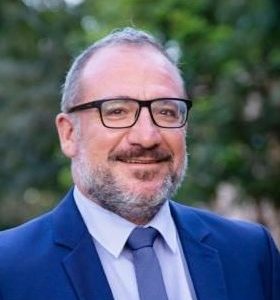
Bruno POZZI
Director, Europe Office, United Nations Environment Programme
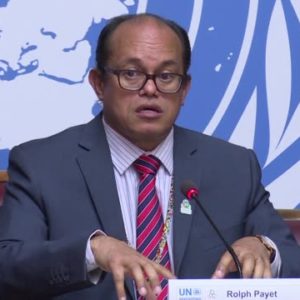
Rolph PAYET
Executive Secretary, Basel, Rotterdam and Stockholm Conventions | The Chemicals and Pollution Agenda
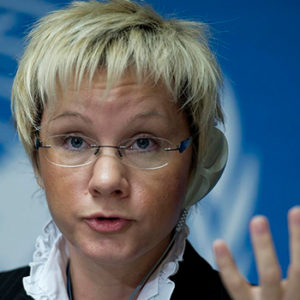
Oksana TARASOVA
Head, Atmospheric Environment Research Division, World Meteorological Organization | The Climate Agenda

David JENSEN
Head, Policy and Innovation, UNEP Environment Crisis Management Branch | The Digital Cooperation Agenda
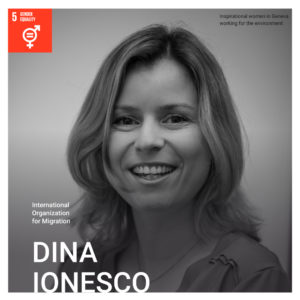
Dina IONESCO
Head of Migration, Environment and Climate Change Division, International Organization for Migration | The Eco-Humanitarian Agenda

Benjamin SIMMONS
Head, Green Growth Knowledge Partnership | The Green Economy Agenda

Yves LADOR
Geneva representative, Earthjustice | The Human Rights and Environment Agenda

Sonia PENA MORENO
Coordinator, Global Biodiversity Policy and Governance, IUCN | The Nature Agenda

Marco KEINER
Director, Environment Division, UN Economic Commission for Europe
Summary
Welcome
Welcome to the International Environment House and to the Geneva Environmental Hub | Bruno Pozzi
- Geneva is an international hub for environmental governance, in support to the Nairobi hub where UNEP is located. This is a central place to reinforce the synergies among the hubs. Indeed, a lot of international organizations, permanent missions, NGOs, platforms and academic institutions that are contributing to the global environmental agenda are based in Geneva.
- We will introduce you to key thematic areas where Geneva has expertise, and to the global environmental agenda and upcoming major events hosted in international Geneva or with major contributions from international Geneva.
Welcome to Geneva | H.E. Amb. Salman Bal
- Geneva is the operational hub of the international system
- CAGI task is to make you feel at home in Geneva
- Geneva hosts various thematic platforms, GEN, the environmental platform being the oldest. They are crucial to newcomers.
- Encouraging you to follow CAGI twitter account @CagiGeneva
- CAGI is the ‘one stop shop’ facilitating the settlement and integration of employees of International Geneva and their family members.
- CAGI assists NGOs and supports delegates attending conferences in Geneva. The assistance and support to International nongovernmental organizations is provided whether already based in, or interested in establishing an office in Geneva.
- CAGI Organizes informal and themed events, open to all, facilitating gatherings between Internationals and the local community.
- CAGI offers also services to spouses and partners of employees of international Geneva.
Chemicals and pollution | Rolph Payet
Geneva a hub for chemicals and waste
- The chemicals and pollution agenda is a very important topic in international Geneva with the presence of key organizations working on this issue, based not only at the International Environment House, but around Geneva: BRS MEAs, Minamata Conv., SAICM, UNEP Chemicals and Health Branch, WHO, ILO, UNITAR, WTO, Human Rights Council, etc. There is a Special Rapporteur on the implications for human rights of the environmentally sound management and disposal of hazardous substances and wastes. We talk about the “Geneva chemicals and waste hub”.
- The plastic issue is very important, and various organizations are working together to address this global issue.
- The Basel, Rotterdam and Stockholm Conventions are under the responsibility of the BRS Secretariat. Each of these covers the cycle from the extraction of raw materials to the disposal and waste management. The Basel Convention covers hazardous wastes and other wastes. The Rotterdam Convention deals with industrial chemicals, pesticides and severely hazardous pesticide formulation. Finally, the Stockholm Convention treats industrial chemicals, pesticides and by-products. The three conventions came together under one secretariat, through the synergies process. There are a lot of benefits from these synergies with pool resources and building of an international capacity for the management of chemicals.
Upcoming meetings
- The Basel OEWG starts today online and a face to face meeting should take place next year
- The Basel, Rotterdam, and Stockholm Conventions triple COPs will be held next year in July, with several preparation briefing meetings to come in the next months.
- The Minamata Convention is a new convention. It celebrated its three years in August. It deals with the problem mercury. Its next COP will be in November 2021.
- The Strategic Approach to International Chemicals Management (SAICM) is a UNEP program. It aims to do an overview of chemicals management from a strategic perspective. The conference of the SAICM has been postponed to next year.
- Regional preparatory meetings will take place prior to all these meetings.
- Operating non-paper meetings for various years. Everything is available on specific intranets developed for these conferences.
Climate
Introduction
- Climate is now on everybody’s agenda. All eyes are on the next climate COP to be held in Glasgow next year, and on the nationally determined contributions of member states expected to lead to the implementation of the Paris Agreement.
- With the presence in Geneva of WMO, the creation and hosting in Geneva of the Intergovernmental panel on climate change (IPCC), more than 30 years ago, and the commitment of the UN Secretary General and his predecessor, as well as all the international community to tackling climate change, this topic is now discussed in almost all fora in Geneva: science, human rights, development, peacebuilding and security, disasters risk reduction, humanitarian, new technologies and innovation, etc.
WMO | Oksana Tarasova
- WMO is the specialized agency for climate. It has its headquarters in Geneva and small regional offices around the world. It’s the second oldest international organization as it originates from 1873. WMO is a specialized agency of the United nations since 1951. The weather and climate are the core of its activities. WMO works with the permanent representatives who are usually the heads of the national meteorological services, representing their countries.
- WHO has five strategic pillars: support of global infrastructure, development of services to the user community, development of related science, promotion of regional cooperation, and support of the members.
- WMO created a network of observational stations to provide information about weather, climate, water and environment. WMO established and maintains the international data exchange and the telecommunication system allowing to have a worldwide exchange of information on weather. WMO created a global standard on information on weather, climate, water and environment.
- Concerning the observation infrastructure: across the World, the meteorological measurements are made according to the standards of WMO. The meteorological stations are everywhere with several thousands of them worldwide. This information goes to the global telecommunication system and then the forecasts are produced with different applications, through nine world meteorological centers and height climate centers.
- When it comes to providing services, WMO has different groups developing services, for example on climate change, they have the Global Framework for Climate Services, dedicating products and services that can support adaption to climate change.
- In the area of science, WMO is a co-sponsor of three important programmes.
- The World Climate Research Program (WCRP) facilitating the research and the science used for the IPCC’s assessments.
- WMO is a core-creator of IPCC with UNEP. The IPCC is working on its next assessment report (AR6) which will be delayed. It will include some special reflections on what we learned from Covid-19.
- WMO is a co-sponsor of the Global Climate Observing System, with UNEP, UNESCO/IOC, and ICS, which aims to understand the state of the climate.
- WMO produces the State of the Climate before the Climate COP, reflecting also on the way beyond.
- WMO created a Global Atmosphere Watch Programme, observing the chemical composition of the atmosphere. It also coordinates the observation of atmospheric substances such as greenhouse gas. WMO produces the annual Greenhouse Gas Bulletin which is usually produced before the Climate COP..
- In the thematic of cooperation, WMO is working with the UNFCCC, UNCCD, and also with other environmental Conventions, the Sendai framework.
Digital Cooperation | David Jensen
The digital revolution
- We are in a time of digital revolution.
- The scale of influence that digital technologies can have is tremendous. Robotic applications can permit to save resources specially in the agriculture.
- We are in a capital moment for humanity relatively to digital technologies as they are transforming the global economy, impacting social relationships, influencing our democracies, reshaping our own humanity.
- From the environmental perspective they offer tremendous opportunities to ignite a revolution in digitalizing environmental sustainability.
- However, digital technologies need to be harnessed in an inclusive, equitable and environmentally sound manner.
- As business as usual is simply not working to achieve the SDGs in the next ten years, digital technologies should be part of the solution as it operated at the speed and scale needed to achieve our collective environmental goals.
- There is a need to hard code environmental goals and norms into the operating system of the digital economy; to use digital technologies to nudge, incentivize, amplify and accelerate sustainable consumption and production; and to collaboratively solve four major problems that will unlock structural transformations in global value-chains.
- There are four key problems to solve.
- First, concerning data fragmentation and silos, we need to build an environmental data infrastructure.
- Second, we don’t have an alignment between our global goals and the finance system, so we must develop sustainable finance and impact investing.
- Third, we are unable to measure and verify sustainability performance of products, consequently we need to use digital technologies to measure the sustainability performance of supply chain.
- Finally, we have a limited influence on consumers’ preferences, so we need to start to actively nudging consumer behaviors toward a sustainable lifestyle.
The role of international Geneva
- International Geneva has a role to play. It’s a center for environmental data and action (pollution, climate, etc.), for business, finance and trade clusters, and for digital transformation and expertise. We can federate all of this to create a digital ecosystem.
- International Geneva can become this global hub for digitalizing environmental sustainability, we need to work on how we can harness digital technologies to drive collaboration and coordination across a decentralized and distributed network of environmental actors and stakeholders at the local and global levels.
UNEP new strategy
- UNEP’s Medium-Term Strategy 2022-2025 is focusing on climate action, nature action, pollution action through four impacts pathways with one entirely dedicated to digital transformations. Digital transformations will go through digital ecosystem architecture and governance, applications of digital public goods, strengthened digital literacy insuring that all stakeholders can engage in the digitalization for the environment, and a digitally enabled UNEP with an increase of digitalization in the business processes, the use of data, and internal and external collaboration.
- A digital transformation task force has been launched at UNEP to help the achievement of those goals.
Eco-Humanitarian | Dina Ionesco
Environment at the center of humanitarian, DRR, human mobility and peacebuilding agendas
- The Eco-humanitarian agenda is present in diverse fora in Geneva.
- Geneva is a hub connecting the humanitarian, development and environmental agendas (the key environmental players allowing the integration of environmental and climate concerns /nature based solutions, ecosystems and biodiversity approaches across the agendas of human rights, humanitarian, SDG, labour, health that are key for the international Geneva)
- Geneva is also a hub connecting the disaster risk reduction (DRR) community, with a strong focus on displacement issues to the climate and environmental agenda (PDD, Sendai implementation, UNDRR, the DRR conferences, etc.). Various organizations are working on how to implement the Sendai Framework for Disaster Risk Reduction and to help member states.
- Moreover Geneva is a hub to understand the social aspects of the climate change and the environment, and the impact of prevention, going beyond answering to humanitarian crisis.
- The Platform on Disasters Displacement (PDD), currently shared by France, aims to implement the
- Nansen Protection Agenda that looks specifically to people who move because of disasters and climate change, and crossing borders. IOM and UNHCR are supporting this initiative.
- The High-Level Panel on Internal Displacement also provides a key space to highlight the environmental drivers of displacement.
- Finally, Geneva is the hub for a very specific and advanced migration/human mobility and climate change/environment agenda: IOM, UNHCR, PDD, IFCR, IDMC, NRC, UNEP, WMO lively civil society actors on the topic as well as academic players that make international Geneva community a champion/leader and an innovation space on the implementation of the Paris agreement and of the
- Global Compact for Migration and Global Compact on Refugees on these matters. There are two pillars supporting actions: First, the climate pillar and the implementation of the Paris Agreement with the task force on displacement (TFD) under the UNFCCC. Made of 13 members, the majority being based in Geneva (IFRC, ILO, IOM, UNHCR, IDMC, NRC, etc.) Second, the mobility pillar, with the Global Compact for Migration (GCM) and the UN Migration network is also based in Geneva and is coordinated by IOM.
- IOM supports member states and migrants to address the multiple challenges related to migration including displacement in the context of environmental degradation, climate change and disaster.
Upcoming meetings
Green Economy | Ben Simmons
Geneva: the economic governance hub
- Geneva is also known as the economic governance hub. The fact that the World Trade Organization is based in Geneva means that many organizations are also located here, including, the World Economic Forum, the World Business Council for Sustainable Development and others.
- What is interesting about Geneva, given the fact that there is all these different hubs, isn’t so much that they are located in Geneva, it’s the ability of Geneva to bring those different groups together: it’s the intersection between those hubs that becomes so unique. The fact that there are trade colleagues working directly with human rights colleagues, migration colleagues and with environmental governance colleagues, is part of the reason why green economy was developed.
- Green economy is looking at how do we create economies and how can we promote economic development and still maintaining environmental sustainability. Geneva is a major hub for these discussions with a number of organizations working on this nexus.
Greening economies
- At the moment, we are under a Covid-19 threat. It’s a major challenge and governments are responding with billions of dollars in stimulus packages. One of the key questions is how governments are going to use that money for stimulus. Will it be used to maintain the economy or will it be used to do something different? So many of the environmental challenges are derived from how we consume and how we produce.
- The Green Growth Knowledge Partnership tempts to work on this. It is a multi-institutional initiative. It was launched initially by the UNEP, the World Bank, the OECD, the Global Green Growth Institute and it is also lead by UNIDO. It brings together over 70 different international organizations and think tanks to look at this nexus and to identify ways that these groups can collaborate. They focus on different issues areas. One of them is knowledge generation: the initiative convenes experts working groups among those institutions but also in academia to try to derive questions around what data and what knowledge do we miss and how can we work together to respond. The initiative also works on creating online platforms to bring all the knowledge and data that is relevant to these issues’ areas to the expert community. It has three platforms: the Green Growth Knowledge Platform (focused on policy community), the Green Finance Platform (focused on the finance community) and the Green Industry Platform. It regroups around 50 000 experts that are using those platforms every month. The Green Growth Knowledge Partnership also supports online activities. In the spring, they had a Covid-19 webinar series with around 5 000 participants.
- There is a tremendous growth in the interest on the nexus between economic development and environmental sustainability, within Geneva and globally.
Upcoming meetings
- The Geneva Trade Week will be taking place from 28 September to 2 October. The Geneva Trade Week will, this year, replace the WTO Public Forum. The WTO Public Forum is an important annual event for Geneva where experts discuss these nexus issues between trade and human rights, trade and the environment and some other important issues. The Geneva Trade Week is a new incarnation and will be held online.
- The UN Environmental Assembly is coming up in February 2021. Many of the decisions of the Environmental Assembly touches aspects on Green Economy and Green Growth, in particular, sustainable infrastructure and mineral resources governance.
- Although it is not taking place in Geneva, the OECD will convene its Green Growth and Sustainable Development Forum online from 24 to 26 November.
- On the website of the Green Growth Knowledge Platform you can find information on every country in the world and what those countries are doing in terms of Green Growth policy, industrial activity and finance.
Human Rights and Environment | Yves Lador
Geneva is the main international hub on human rights issues
- Geneva is the main international hub on human rights issues. Most if not all international universal human rights organs are based in Geneva.
- The most well known is the Human Rights Council which brings together a number of states which is a subsidiary body of the UN General Assembly. It meets three times a year and have other meetings between these regular sessions. The Council, the members of the Council and the observers of the other states or civil society work all the year around on these issues, as many other groups such as Universal Periodic Review, and working groups regulary meet.
- Michelle Bachelet is the High Commissioner for Human Rights. The High Commissioner is a body of its own, it is not just a secretariat to the Human Rights Council, it is a body of the UN and plays an important role. Michelle Bachelet has taken various strong positions, including on the right to a healthy environment.
- As environmental issues have grown within the work of the Human Rights Council, there has been an agreement between the High Commissioner and the Executive Director of UNEP. One of the outcomes of this close collaboration is the publication on the response to Covid called: “Human Rights, the Environment and Covid-19”. It gives the keys elements on how the environment and human rights are interlinked in what happened with Covid and also with the development of the Covid response.
- There are other types of relations because there are bodies as the Special Procedures which are independent. There is a Special Rapporteur on the Human Rights and the Environment.
- There are the Treaty Bodies that are ratified by countries. These Treaty Bodies have groups of experts who overlook the implementation of these treaties.
- The Universal Periodic Review (UPR) is a unique process which involves a review of the human rights records of all UN Member States. The UPR is a State-driven process, under the auspices of the Human Rights Council, which provides the opportunity for each State to declare what actions they have taken to improve the human rights situations in their countries and to fulfill their human rights obligations.
In focus: Environmental Human Rights Defenders
- The Human Rights Council focuses on different issues. One of them is the protection of people who are acting for the environment called the “environmental defenders” or “human rights defenders”.
- Last year, a resolution was adopted by consensus at the Human Right Council about the protection of the people who are acting for the environment. It has been followed by a road-map to see how, at the international level, researchers, academics, states and civil society can join forces in order to make sure that the growing trends of attack against people who are defending the environment including official governmental civil servants, rangers and people from the civil society. “If you kill the people who are protecting the environment you will never reach any real protection of the environment”. This is a crucial matter. In this issue, we can count on the work that is done by the Special Rapporteur of the Human Rights Council on human rights defenders. A new mandate holder has now started and is as committed as her predecessor.
- The Aarhus Convention on access to information, public participation and access to justice in environmental matters, hosted by UNECE, is also devoting a part of its work on the protection of environmental defenders. The Escazú convention in Latin America is working in the same direction.
In focus: Climate Change
- The Human Rights Council has had regularly resolutions on climate change.
- Now, there is an annual thematic resolution on this topic.
- This year it will be working on how the climate change impacts the rights of older persons.
- A discussion now ongoing at the council is on a call to have a new special procedures on human rights and climate change, launched by Marshall Islands, Fiji, Climate Vulnerable Forum, and other States of the Pacific.
In focus: toxic substances
- The Special Rapporteur on the implications for human rights of the environmentally sound management and disposal of hazardous substances and wastes, Marcos A. Orellana has just been nominated. The mandate has been created in 1995.
- It works in close relations with all of the procedures presented before about SAICM and so on. (see chemicals and pollution discussion)
In focus: The right to a safe, clean, healthy and sustainable environment
- The Special Rapporteur on human rights and the environment, David R. Boyd, is really involved in the promotion of a number of groups at the Human Rights Council, in order to have a global recognition of the right to a safe, clean, healthy and sustainable environment. The hope to have this global recognition next year.
Nature | Sonia Pena Moreno
Introduction
- Humans are part of nature and still they are threatening it.
- It is essential to look at nature in a different way: nature is part of the solution and nature can be an essential part to the answer to the planetary crisis.
- In Geneva and in its surroundings, there are various organizations dealing with nature: the IUCN, the WWF, the Mava Foundation, the Convention on Wetlands, the Convention on International Trade in Endangered Species of Wild Fauna and Flora (CITES), among others.
IUCN
- IUCN is not based in Geneva, but they are very close, in Gland. The IUCN was established in 1948. The IUCN recognizes itself as the global authority on the status of the natural world and the measures needed to safeguard it. IUCN provides knowledge and tools, critical for ensuring that human progress, economic development and nature conservation take place together. Its vision is “a just world that values and conserves nature”. IUCN has for mission to influence, encourage, assist societies throughout the world to conserve the integrity and diversity of nature and to ensure that any use of natural resources is equitable and ecologically sustainable.
- IUCN is a hybrid organization, they are not attached to the UN but they work very close to UN agencies. They have members coming from the states and governments agencies as well as a large number of members coming from non-governmental organizations (NGOs) situated around the world, at different levels of governance with big international NGOs and other small, concrete, field-based organizations. In 2016, they added a new category of membership: the indigenous people organizations, with currently 17 intergovernmental organizations that are dealing with indigenous people. The variety of IUCN actors is challenging but it offers a lot of expertise with different point of views and angles that enhanced the work of IUCN.
- IUCN has around 15 000 of experts sitting at the six experts’ commissions, looking at specific issues from species to protected areas and ecosystem. IUCN collaborates with many organizations around the world, being its members or partners including with civil society organizations and the business sector. It does it thanks to its 900 staffs based at the headquarters in Gland and in offices around the world.
- IUCN provides action through their knowledge products and tools to influence decision-making process. This is done at the international policy level as well as at the field, national, local level.
- IUCN contributes to action by generating data. The most known is the Red List of Threatened Species, updated yearly, providing an assessment of where we are in terms of species and whether species see their status improving or being close to extinction.
- IUCN provides analysis with knowledge products to inform decision makers.
- IUCN provides large convene platform or space, with the most recognizable of all: the IUCN World Conservation Congress. This congress takes place very four years and gathers more than 1 400 members to decide the work and the budget of IUCN and to consider the policies and the decisions presented to IUCN members that, when adopted, become resolutions or recommendations. Resolutions and recommendations set IUCN general policy. Many multilateral agreements were born out of resolutions and recommendations from IUCN, some in Geneva as the Ramsar Convention on Wetlands and the CITES, among others.
- The pandemic has postponed the IUCN World Conservation Congress to 7 to 16 January 2021, initially scheduled in June, in Marseilles. IUCN is currently discussing with the host country on the formalities. This congress is a very important gathering for environmental and nature conservation.
- IUCN engages through a lot of field projects and actions on the ground to influence policy decision making for better conservation, information…
The global nature agenda
- Concerning the Nature Agenda, the Intergovernmental Science-Policy Platform on Biodiversity and Ecosystem Services (IPBES) published a Global Assessment, in 2019, that underlined that at least one in four species are at risk of extinction. It also highlighted that 1 million species are at threat of extinction. This set the alarm to the world that we need to transform the way that we work and consume to be aligned with environmental targets.
- Based on the Global Assessment, the international community is renewing its strategic plan for biodiversity and new targets for biodiversity (ongoing). The Convention on Biological Diversity (CBD) established on Open-Ended Working group on the Post-2020 Global Biodiversity Framework. The idea is to create a roadmap for the next 10 years, until 2030, aligned with the SDGs, that will focus on biodiversity conservation.
- The IUCN World Conservation Congress is seen as a milestone in that process, gathering IUCN members and others that come to the congress to keep the discussion going on those targets and goals that need to be set for nature conservation. It should take place in January 2021 in Marseilles.
- This year is a very important year because some of the nature targets that are included in the SDGs are ending this year as they had for deadline 2020.
- This year also, the High level Biodiversity Summit is taking place at the 75th UN General Assembly virtually in September 2020. This is a good opportunity to put into the UN agenda the importance of linking nature, health, economics and climate.
- The plan was to adopt the global biodiversity post-2020 framework by the end of the year but the CBD COP15 that is supposed to adopt it has been postponed to 2021 (potentially September-October).
- Other organizations in Geneva are also following this nature agenda such as WWF and WBCSD among others. For example the WBCSD brings the private sector perspective.
UNECE | Marco Keiner
Action is needed. To act in international Geneva means to use multilateral platforms that are real tools to bring together governments, stakeholders in notably the pan-European region. The United Nations Economic Commission for Europe (UNECE) sets a number of norms, standards and a number of conventions to facilitate the cooperation on environmental matters.
- UNECE covers 56 member states, on three continents. UNECE aims to help countries to develop norms and conventions. Its mandate is to foster economic integration and to promote sustainable development. So far, UNECE has produced global public goods that are freely available to all countries, citizens and companies. They are used in more than 100 countries around the world. UNECE has nine sub-programs overlapping in nexus areas to use the scarce resources efficiently. Several of UNECE mandates have a global outreach.
- Concerning sustainable transport, UNECE is the home to the Inland Transport Committee on road rail and inland waterways, equivalent to ICAO for aviation and IOM for the maritime sectors. It administers 59 conventions that are providing global legal regulatory framework for key transport issues. This relates to vehicle regulation for safety and efficiency, to road safety, to global facilitation with the International Road Transports (TIR) Convention, to rules to insure a safe transport of dangerous goods. It is a convening platform for all the countries.
- In the field of environment, UNECE has 12 multilateral environmental agreements, 5 conventions plus their protocols: the Aarhus Convention, the Espoo Convention on Environmental Impact Assessment, the Convention on Long-Range Transboundary Air Pollution, the Convention on the Protection and Use of Transboundary Watercourses and International Lake, and the Convention on the Transboundary Effects of Industrial Accidents. UNECE supports capacity-building in countries to enhance the knowledge of experts and to strengthen the authorities’ knowledge in the country. UNECE assesses the environmental governance of countries and provides advice on how to improve it.
- In the area of trade, UNECE elaborates policy recommendations to remove tariff barriers to trade. So far, it has created 480 standards and recommendations on trade facilitation and electronic business in the United Nations Centre for Trade Facilitation and Electronics Business (UN/CEFACT). It aims to improve the traceability for example in the fishing industry and to improve the textile value-chains. In the trade sub-program, UNECE has created over 100 international agricultural quality standards.
- On innovation and competitiveness, UNECE created international standards for public/private partnerships and it undertakes innovation performance reviews.
- Another sub-program is on sustainable energy, developing notably international classification system for energy and mineral resources. It focuses on advancing energy efficiency, reducing the ecological footprint of fossil fuels and supporting green and renewable energy.
- UNECE has a sub-program on housing and land management. This program has published the Geneva UN Charter on Sustainable Housing that is used worldwide. Through this sub-program they share best-practices and standards on energy efficiency in buildings. It elaborates housing country profiles to give recommendations for national governments on how to improve land fields planning and the building sector. They offer smart cities indicators and profiles.
- On forests, UNECE has a joint section with the Food and Agriculture Organization of the United Nations (FAO) to support countries to achieve sustainable forest management with the Rovaniemi Action Plan for the Forest Sector in a Green Economy. It issues a market review on forest products and forest resources.
- On population, UNECE provides policy brief and roadmaps on mainstreaming ageing. It proposes an index to measure active ageing and undertake reviews of countries progress in implementing an action plan on ageing.
- UNECE also works on statistics with a knowledge hub for innovation and modernization of official statistics. So far, it has developed 36 standards and recommendations including on measuring sustainable development, climate change and statistics.
On the agenda in the upcoming months
- UNECE Forum of Mayors 2020, to be held in Geneva in October, will champion the role of local actors in addressing the climate crisis.
- The Executive Body meeting of the Air Convention will meeting in Geneva (17-18 December).
- The Conference of the Parties to the Espoo Convention should take place in Vilnius at the end of the year (8-11 December), as well as, the Conference of Parties to the Convention on the Transboundary Effects of Industrial Accidents in Bonn (1-3 December).
- The Regional Forum on Sustainable Development is planned to be in March 2021 followed by the Commission Session of UNECE focusing on application of circular economy principles in sustainable tourism.
Conclusion
- The environmental agenda in Geneva is strong and we have to contribute and act now.
Video
The event was live on facebook.
Documents
- Invitation
- H.E. Amb. Salman Bal Presentation
- Roph Payet Presentation
- David Jensen Presentation
- Sonia Pena Moreno Presentation
- Marco Keiner Presentation
Links
Chemicals and Pollution
- Geneva Environment Network key area: Chemicals and Pollution
- Basel, Rotterdam and Stockholm Conventions Secretariat (BRS MEAs)
- UNEP Chemicals
- SAICM
- Minamata Convention on Mercury
- Basel Convention OEWG
- Basel, Rotterdam, and Stockholm Conventions triple COPs
- WHO
- ILO
- UNITAR
- WTO
- Human Rights Council
- Special Rapporteur on the implications for human rights of the environmentally sound management and disposal of hazardous substances and wastes
- Fourth meeting of the Conference of the Parties to the Minamata Convention on Mercury (COP4)
- Fifth Session of the International Conference for Chemicals Management (ICCM5)
Climate
- Geneva Environment Network key area: Climate
- WMO
- IPCC
- UNFCCC
- UNCCD
- Sendai Framework for Disaster Risk Reduction 2015-2030
- UN Climate Change Conference 2021
- The Paris Agreement
- WMO standard on information on weather, climate, water and environment
- Global Framework for Climate Services
- World Climate Research Program
- IPCC Sixth Assessment Report
- Global Climate Observing System
- Global Atmosphere Watch Programme
Digital Cooperation
Eco-Humanitarian
- Geneva Environment Network key area: Eco-Humanitarian
- IOM and Migration, Environment and Climate
- UNDRR
- Disasters Displacement Platform
- Sendai Framework for Disaster Risk Reduction
- Nansen Protection Agenda
- High-Level Panel on Internal Displacement
- Global Compact for Migration
- Global Compact on Refugees
- Task Force on Displacement
- UN Network on Migration
- IDMC 2020 Annual Conference
Green Economy
- Geneva Environment Network key area: Green Economy
- Green Growth Knowledge Partnership
- World Trade Organization
- World Economic Forum
- World Business Council for Sustainable Development
- Green Growth Knowledge Platform
- Green Finance Platform
- Green Industry Platform
- Geneva Trade Week 2020
- Fifth session of the United Nations Environment Assembly
- OECD Green Growth and Sustainable Development Forum
Human Rights and Environment
- Geneva Environment Network key area: Human Rights and Environment
- Special Rapporteur on human rights and the environment
- Special Rapporteur on the implications for human rights of the environmentally sound management and disposal of hazardous substances and wastes
- Special Rapporteur on the situation of human rights defenders
- Human Rights Council
- High Commissioner for Human Rights
- UNEP report on Human rights, the environment and Covid-19
- Special Procedures of the Human Rights Council
- Human Rights Treaty Bodies
- Universal Periodic Review
- Resolution A/C.3/74/L.31/Rev.1 of the United Nations General Assembly on human rights defenders
- Aarhus Convention
Nature
- Geneva Environment Network key area: Nature
- IUCN
- WWF
- Mava Foundation
- Convention on Wetlands
- Convention on Biological Diversity
- Convention on International Trade in Endangered Species of Wild Fauna and Flora
- Red List of Threatened Species
- IUCN World Conservation Congress 2020
- Global Assessment Report on Biodiversity and Ecosystem Services
- High level Biodiversity Summit
- CBD COP15
UNECE
- United Nations Economic Commission for Europe Environment Division
- Forests
- Sustainable Energy
- Sustainable Transport
- Inland Transport Committee
- International Road Transports (TIR) Convention
- Environmental Policy
- Aarhus Convention
- Espoo Convention on Environmental Impact Assessment
- Convention on Long-Range Transboundary Air Pollution
- Convention on the Protection and Use of Transboundary Watercourses and International Lake
- Convention on the Transboundary Effects of Industrial Accidents.
- Population
- Innovation and Competitiveness
- Housing and Land Management
- Statistics
- Trade
- United Nations Centre for Trade Facilitation and Electronics Business
- UNECE Forum of Mayors 2020
- Fortieth session of Executive Body of the Air Convention
- Eight session of the Conference of the Parties to the Espoo Convention
- Eleventh meeting of the Conference of Parties to the Convention on the Transboundary Effects of Industrial Accidents
